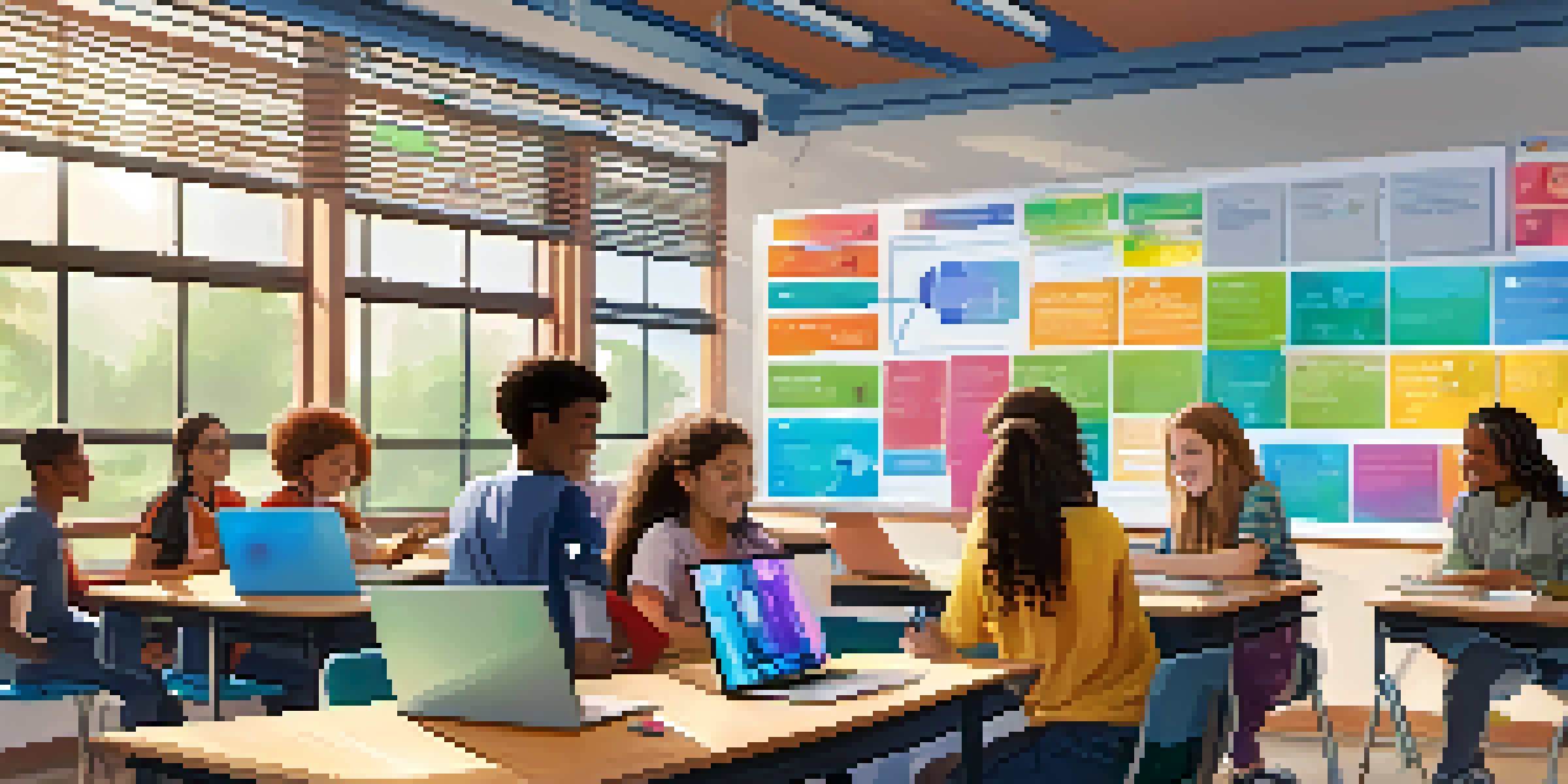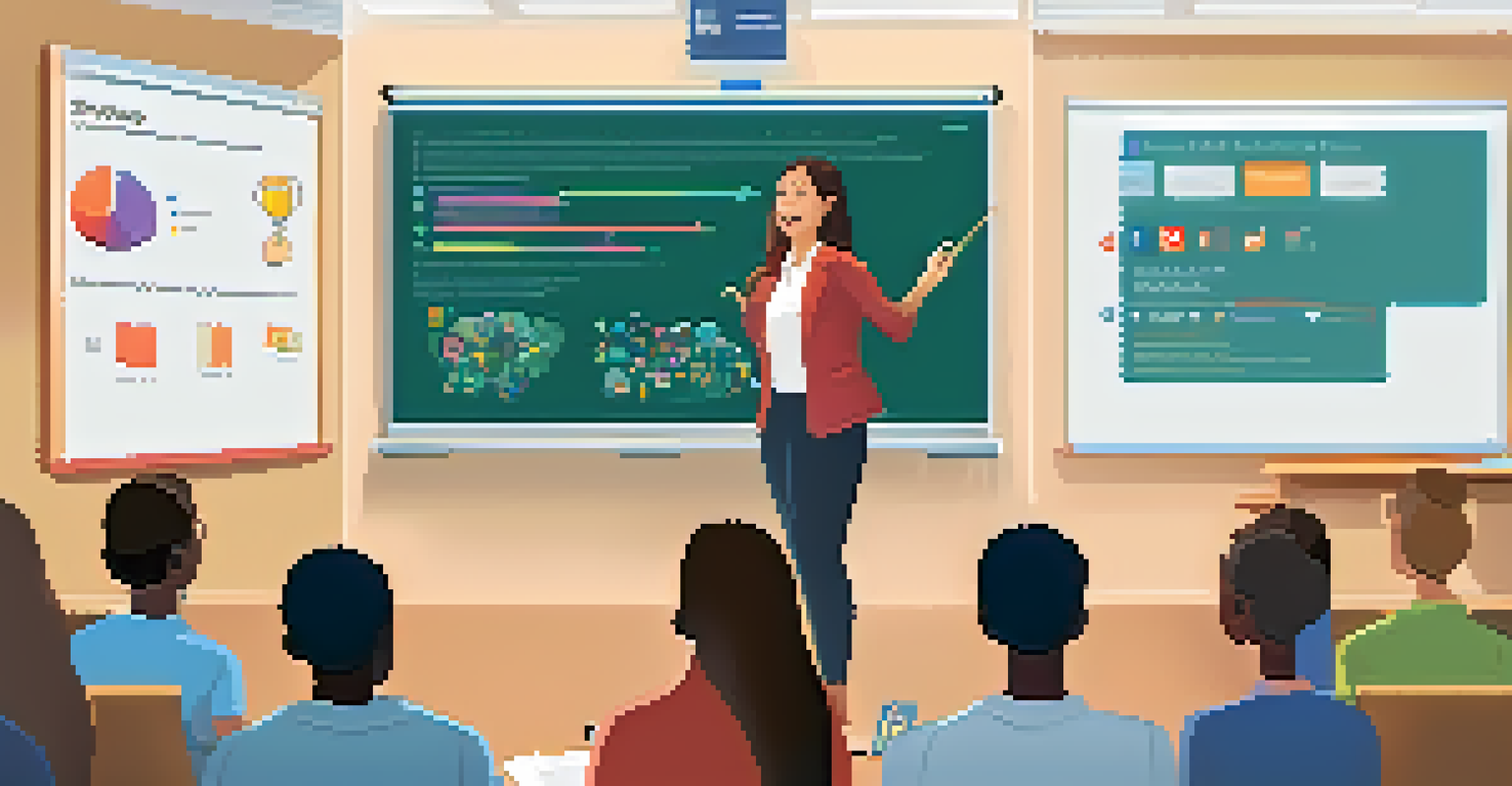Integrating Social Media into Curriculum for Enhanced Learning

Understanding the Role of Social Media in Education
Social media has become a staple in our daily lives, transforming how we communicate and interact. This shift also extends to education, where platforms like Twitter, Facebook, and Instagram can be leveraged to create a more engaging learning environment. By understanding the role of social media, educators can tap into its potential to enhance communication and collaboration among students.
The great thing about social media was how it gave a voice to voiceless people.
Imagine a classroom where students can share ideas and resources in real-time, just like they do with their friends online. This dynamic interaction can foster a sense of community and motivate students to participate actively in their learning. By integrating social media into the curriculum, teachers can bridge the gap between traditional learning and students' everyday experiences.
Furthermore, social media provides access to a wealth of information and diverse perspectives. This variety can enrich discussions and encourage critical thinking, essential skills in today's fast-paced world. In essence, social media can serve as a powerful tool to complement traditional teaching methods.
Creating a Social Media Strategy for Your Curriculum
To effectively integrate social media into the curriculum, educators should start by developing a clear strategy. This involves identifying specific goals, such as enhancing student engagement or improving communication skills. By setting these objectives, teachers can tailor their approach to meet the unique needs of their students and the curriculum.

For instance, a strategy could include using Twitter for quick updates and announcements or creating a class blog to encourage reflective writing. By outlining the purpose of each platform, educators can ensure that social media complements rather than distracts from the learning experience. It's crucial to consider the age and maturity of students when selecting appropriate platforms.
Social Media Enhances Learning
Integrating social media into education fosters communication and collaboration, making learning more engaging for students.
Additionally, educators should establish guidelines for social media use in the classroom. Clear expectations can help students navigate these spaces responsibly, fostering a safe and respectful online environment. This proactive approach can empower students to utilize social media thoughtfully and effectively.
Enhancing Collaboration through Social Media Tools
One of the most significant benefits of social media in education is its ability to enhance collaboration among students. Platforms like Google Classroom, Slack, or even Facebook groups enable students to work together on projects, share resources, and provide feedback to one another. This collaborative approach mirrors real-world scenarios where teamwork is essential.
Social media is about the people! Not about your business. Provide for the people and the people will provide you.
Consider a group project where students can use a private Facebook group to discuss ideas, share documents, and post questions. This not only fosters teamwork but also helps students develop crucial communication skills. They learn to express their thoughts clearly and respectfully, preparing them for future professional environments.
Moreover, social media can connect students with peers from different backgrounds or geographical locations. By collaborating with others outside their immediate circle, students gain diverse perspectives that enrich their learning experience. This global interaction can broaden their understanding of various cultures and ideas, making education more inclusive.
Leveraging Social Media for Real-World Learning
Integrating social media into the curriculum can also provide students with real-world learning opportunities. By engaging with industry professionals or participating in relevant online discussions, students can gain insights into various fields and potential career paths. This connection between education and the professional world is invaluable in today's job market.
For example, a class could follow industry leaders on Twitter and engage with their content, asking questions or sharing thoughts. This not only enhances learning but also helps students build networks that can benefit them in the future. The ability to interact with real-world experts can make lessons more meaningful and applicable.
Create a Social Media Strategy
Developing a clear strategy for social media use in the classroom helps educators meet specific learning goals and enhances student engagement.
Additionally, social media can be a platform for students to showcase their work to a broader audience. This exposure can boost their confidence and motivate them to produce high-quality work. By understanding the impact of their contributions, students can develop a sense of purpose and ownership over their learning.
Promoting Digital Citizenship through Social Media Use
As educators integrate social media into the curriculum, it's essential to emphasize the importance of digital citizenship. This concept encompasses responsible online behavior, including respecting others' opinions, understanding privacy settings, and recognizing the permanence of digital footprints. Teaching these skills is crucial in preparing students for a digital world.
Imagine a scenario where students engage in a heated online debate. By guiding them on how to express differing opinions respectfully, educators can foster a culture of constructive dialogue. This skill not only benefits their academic journey but also prepares them for respectful interactions in their personal and professional lives.
Moreover, discussing the implications of sharing personal information online can help students navigate the complexities of social media. By instilling awareness and responsibility, educators can empower students to make informed decisions and become positive contributors to the digital landscape.
Assessing the Impact of Social Media on Learning Outcomes
To ensure the successful integration of social media in the curriculum, educators must assess its impact on learning outcomes. This involves collecting data on student engagement, collaboration, and overall performance. By analyzing this information, teachers can determine what strategies work best and make necessary adjustments.
For instance, educators might conduct surveys or focus groups to gather student feedback on their social media experiences. This input can provide valuable insights into how these platforms affect motivation and understanding. By prioritizing student voices, teachers can create a more tailored and effective learning environment.
Promote Digital Citizenship Skills
Emphasizing digital citizenship prepares students for responsible online behavior and respectful interactions in the digital world.
Additionally, tracking specific metrics, such as participation rates in online discussions or the quality of collaborative projects, can help quantify the benefits of social media integration. This data-driven approach allows educators to showcase the value of using social media as a learning tool and advocate for its continued use.
Overcoming Challenges of Social Media Integration in Education
While integrating social media into the curriculum offers numerous benefits, it also comes with its challenges. Issues such as distractions, cyberbullying, and varying levels of digital literacy among students can hinder the effectiveness of social media as a learning tool. Addressing these concerns is essential for successful implementation.
For example, educators can establish clear guidelines and expectations for social media use, minimizing distractions during class time. Encouraging focused discussions and setting specific goals for online interactions can help keep students on track. Proactive measures can significantly reduce potential disruptions.

Additionally, providing resources and support for students struggling with digital literacy can help bridge the gap. Offering workshops or tutorials on effective online communication can empower all students to participate fully. By addressing these challenges head-on, educators can create a positive and productive learning environment.